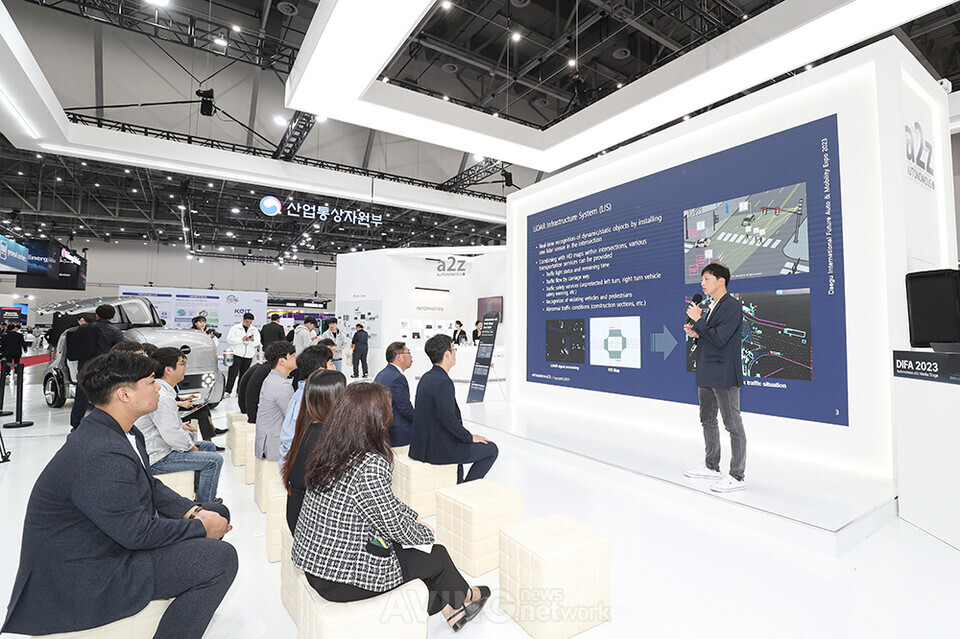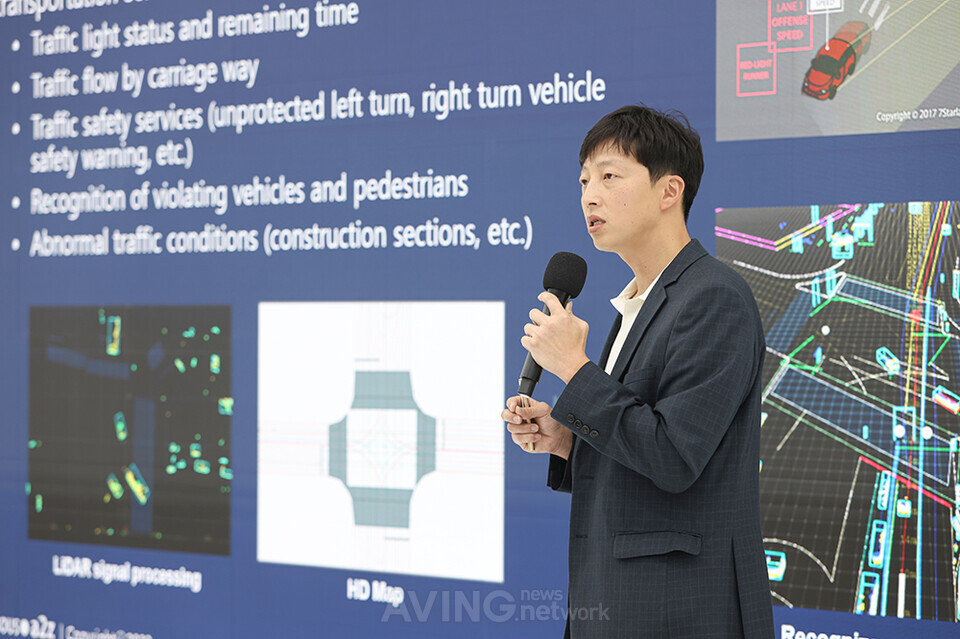Press Donghyeong Seong, Singapore country manager of Autonomous a2z, presents "LiDAR Sensors! A single camera sensor can do the job of eight... We will develop LiDAR technology that is fully compatible…
페이지 정보
작성자 Autonomous a2z 조회 159 작성일 2023-11-06본문
Donghyeong Seong, Singapore country manager of Autonomous a2z, speaks at the forum session “Current Status of Domestic Autonomous Mobility Infrastructure (Cases) and Ways to Improve” at the Autonomous a2z booth in the 2023 DIFA on October 19th | Photo by AVING NEWS
- Autonomous a2z unveils LiDAR Infra System (LIS) technology in the 2023 DIFA
Autonomous a2z, an autonomous mobility company that develops a driverless mobility platform, held a forum on the topic of “Current Status (Cases) of Domestic Autonomous Mobility Infrastructure and Ways to Improve” at the “2023 Daegu International Future Auto & Mobility Expo (hereinafter DIFA)” in Daegu EXCO on October 19th.
At the forum, Autonomous a2z also emphasized that its self-developed LiDAR Infra System (LIS) can be effectively utilized to prevent dangerous situations on the road.
Donghyeong Seong, Singapore country manager of Autonomous a2z, spoke on the media stage at the Autonomous a2z booth on Thursday, April 19th, the first day of the 2023 DIFA, to introduce the capabilities of LIS and explained the research projects currently underway in Singapore.
LIS is a platform developed by Autonomous a2z based on the technology it has accumulated through research and demonstration of autonomous vehicles. LiDAR stands for "Light Detection And Ranging," and LIS utilizes these characteristics of LiDAR to provide information to prevent accidents.
Previously, Autonomous a2z participated in the COSMO (COnnected Smart MObility) project organized by Singapore's A*STAR (Agency for Science, Technology and Research) in August to showcase LIS. The COSMO project is an initiative by Singapore to identify the technological capabilities of local and international companies and institutions, and to discuss collaborations between industry, academia, and research.
At the event, Autonomous a2z was selected as the Korean representative and delivered the opening keynote, while unveiling the LIS to open up the Singapore market. LIS is currently being pilot-operated in Singapore.
“LIS can be powered by both LiDAR sensors and camera sensors, but LiDAR sensors are exceptionally efficient in terms of performance,” said Manager Seong. "You only need to install one LiDAR sensor to see all nearby traffic, but you need to install four to eight camera sensors to cover each direction of the intersection."
In addition, since the point data acquired by LiDAR sensors is small in size, such data can be processed with less computing power than video data, which thus transmits a relatively large amount of data. Another advantage of using lasers is that they don't recognize personal information such as license plates or human faces.
“The ultimate goal of LIS is to ensure road traffic safety,” said Manager Seong. “LiDAR sensors can accurately determine short-range locations and provide accurate information regardless of environmental factors such as day, night, and weather. Yet, it will not raise any privacy concerns.”

Donghyeong Seong, Singapore country manager of Autonomous a2z, speaks at the forum session “Current Status of Domestic Autonomous Mobility Infrastructure (Cases) and Ways to Improve” at the Autonomous a2z booth in the 2023 DIFA on October 19th | Photo by AVING NEWS
LIS uses "precision maps" in its information collection process. It combines information learned and acquired through precision maps with "point data" from sensors. This functionality of the LIS compensates for the shortcomings and limitations of the existing sensors in today's autonomous vehicles. Current LiDAR, radar, and camera sensors have difficulty identifying shaded areas caused by buildings, trees, and other vehicles near the road. Of course, these problems are also present in normal vehicles with human drivers.
LIS also has the ability to recognize things in a very clear way. When the system detects movement on the road, it can distinguish between vehicles and pedestrians, as well as their location, size, direction of travel, and speed. In addition, the system has the ability to learn traffic systems to determine if a vehicle is running a red light, making an illegal U-turn, or stopping illegally. For people, the system can even see if a pedestrian is crossing the street, waiting to cross the street, etc.
Manager Seong also showed an experimental video of an autonomous vehicle using LIS to recognize an accident or dangerous situation in advance and avoid it. The test was conducted on roads in Singapore, where right turns should follow the traffic signal system, unlike in Korea.
There were three hypothetical situations in which the LIS-equipped vehicle ▲ was driving slowly to avoid a collision with a pedestrian obscured by two illegally parked and stopped vehicles in front while going straight, ▲ stopped immediately after spotting the pedestrian while turning left in the last lane with a large structure blocking the left side of the vehicle's view, and ▲ stopped when a single vehicle was running at a high speed behind a vehicle waiting for a signal in the opposite reverse lane while turning right under a normal signal and resumed driving in a safe condition. In this experiment, the LIS-equipped autonomous vehicle did not collide with a pedestrian.
Manager Seong said, “LIS can prevent accidents by communicating information on potential road hazards to the vehicle or control center. The goal of the system is to ensure road safety by obtaining information about ‘blind’ areas in advance and provide warnings of nearby vehicles," he added.
Manager Seong commented, "The LIS developed by Autonomous a2z is designed for autonomous vehicles, so it has some limitations in terms of road compatibilities. We are currently developing a LiDAR technology that is fully compatible with all roads. We are also researching smart traffic systems and use cases."
Meanwhile, the 2023 DIFA, which has been held for the seventh time in Daegu since 2017, covered the entire mobility industry, including eco-friendly vehicles (electric and hydrogen), motorized parts such as motors, batteries, and chargers, autonomous driving, and urban air mobility (UAM) under the theme of From the ground to the sky, a new beginning of mobility. In particular, as the Ministry of Land, Infrastructure, and Transport and the Ministry of Trade, Industry, and Energy, the co-host Ministries, are the two main pillars of policy promotion in preparation for the era of full autonomous driving services and UAM commercialization through 2027-2030, the exhibition showcased the technological achievements supported by the policy focus and introduced the latest policy directions.

Donghyeong Seong, Singapore country manager of Autonomous a2z, speaks at the forum session “Current Status of Domestic Autonomous Mobility Infrastructure (Cases) and Ways to Improve” at the Autonomous a2z booth in the 2023 DIFA on October 19th | Photo by AVING NEWS


